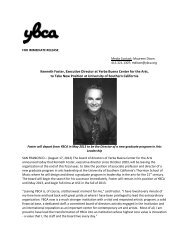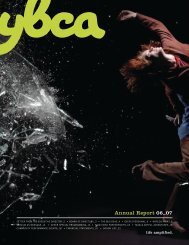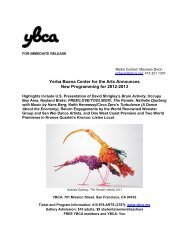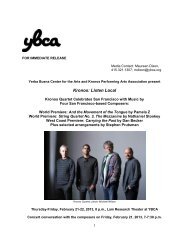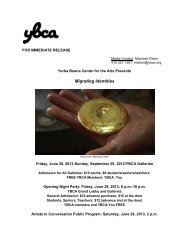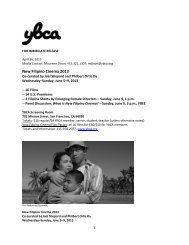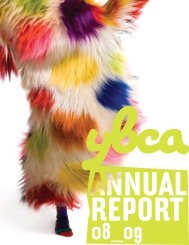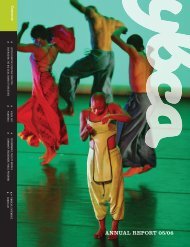2007-2008 - Yerba Buena Center for the Arts
2007-2008 - Yerba Buena Center for the Arts
2007-2008 - Yerba Buena Center for the Arts
You also want an ePaper? Increase the reach of your titles
YUMPU automatically turns print PDFs into web optimized ePapers that Google loves.
TEAROOM<br />
By William E Jones<br />
Oct 26–27, <strong>2007</strong> // Screening Room<br />
Tearoom consists of footage shot by police during a<br />
crackdown on public sex. In <strong>the</strong> summer of 1962, <strong>the</strong><br />
Mansfield Ohio Police Department photographed men in<br />
a public restroom under <strong>the</strong> main square of <strong>the</strong> city.<br />
The cameramen hid in a closet and watched <strong>the</strong> activities<br />
through a two-way mirror. The film <strong>the</strong>y shot was<br />
used as evidence against <strong>the</strong> defendants, all of whom<br />
were found guilty of sodomy, which at that time carried<br />
a mandatory minimum sentence of one year. Jones<br />
discovered <strong>the</strong> footage while he was researching this case<br />
<strong>for</strong> a documentary project. The unedited, silent scenes<br />
were so powerful that <strong>the</strong> director decided to present <strong>the</strong><br />
footage with minimum intervention. Tearoom is a radical<br />
example of film presented “as found” <strong>for</strong> <strong>the</strong> purpose of<br />
circulating historical images that have o<strong>the</strong>rwise been<br />
suppressed. (1962/<strong>2007</strong>, 56 min, Betacam SP, silent)<br />
MASSILLON<br />
By William E Jones<br />
Oct 28, <strong>2007</strong> // Screening Room<br />
Jones returns to his hometown to construct an unconventional<br />
and moving autobiography. Challenging some<br />
of <strong>the</strong> most entrenched notions of filmmaking, Massillon<br />
tells its story without a single human actor, by combining<br />
stunning cinematography with a seductive voice-over<br />
narration. (1991, 70 min, 16mm)<br />
RED STATE CINEMA: RURAL AUTEURS<br />
Representations of rural areas in cinema tend to be <strong>the</strong><br />
condescending and downright mean. This series will<br />
present films made by and about Sou<strong>the</strong>rn rural artists<br />
with unique, individual voices.<br />
POOR WHITE TRASH II<br />
By S.F. Brownrigg; Introduced by David Szulkin<br />
Nov 1, <strong>2007</strong> // Screening Room<br />
S.F. Brownrigg is an extraordinary, unsung filmmaker from<br />
Texas. Though his films were marketed with sleazy titles<br />
and distributed mostly on <strong>the</strong> drive-in circuit, <strong>the</strong>y are deeply<br />
personal and meticulous Sou<strong>the</strong>rn Gothic psychodramas.<br />
David Szulkin, Brownrigg’s biographer (and author<br />
of <strong>the</strong> stunning Wes Craven’s Last House on <strong>the</strong> Left), will<br />
personally introduce and discuss <strong>the</strong> film, a claustrophobic,<br />
sweaty tale of a lost woman trapped by an incestuous,<br />
murderous backwoods family. (1974, 90 min, 35mm)<br />
BLOOD OF JESUS<br />
By Spencer Williams<br />
Nov 4, <strong>2007</strong> // Screening Room<br />
Blood of Jesus is a classic example of <strong>the</strong> “race film”<br />
genre by African-American directors and casts, shown<br />
and marketed exclusively to an African-American audience.<br />
This visionary morality tale is about a woman who<br />
is accidentally shot to death by her husband. Facing<br />
death, she must choose between Hell, represented as<br />
urban life, and Zion, represented as pastoral, rural<br />
America. Preceded by Pitch a Boogie Woogie(1948), a<br />
rare all-black-cast musical short from Greenville, North<br />
Carolina. (1941, 56 min, 16mm; plus short)<br />
CHILD BRIDE<br />
By Harry Revier<br />
Nov 7, <strong>2007</strong> // Screening Room<br />
The most shocking and licentious exploitation film of <strong>the</strong><br />
1930s, Child Bride is a grossly fabricated illustration of<br />
<strong>the</strong> illicit ills of child marriage. Down in Appalachia, on<br />
Thunderhead Mountain, inbred, uneducated girls are<br />
swapped among coarse middle-aged menfolk. The people<br />
are portrayed as living in a sequestered world, out of step<br />
with modern values and customs. (1938, 62 min, 16mm)<br />
DIRTY COUNTRY<br />
By Joe Pickett & Nick Prueher<br />
Nov 9, <strong>2007</strong> // Screening Room<br />
Meet Larry Pierce: a small-town factory worker and<br />
family man who happens to be <strong>the</strong> raunchiest country<br />
music singer in America. Without <strong>the</strong> time or money<br />
to pursue a legitimate career in country music, Larry<br />
is content to lead an ordinary life and moonlight as a<br />
dirty country singer. But when he is <strong>for</strong>ced into early<br />
retirement at his factory job of 30 years, Larry faces an<br />
uncertain future. That is, until a young band with dirty<br />
songs of its own shows up at his door and offers to take<br />
Larry onstage. (<strong>2007</strong>, 75 min, Digital Betacam)<br />
THE TRUE MEANING OF PICTURES: SHELBY<br />
LEE ADAMS’ APPALACHIA<br />
By Jennifer Baichwal<br />
Nov 11, <strong>2007</strong> // Screening Room<br />
This film is a fascinating introduction to <strong>the</strong> work of renowned<br />
photographer Shelby Lee Adams. Born in Eastern<br />
Kentucky, Adams has devoted his life to making portraits<br />
of families living in Appalachia, those who have been<br />
misrepresented in <strong>the</strong> media and derogatorily referred to<br />
as “hillbillies.” The film also delves into <strong>the</strong> controversy that<br />
surrounds Adams’ work amongst those who question his<br />
ethics. Preceded by <strong>the</strong> short Mountain Farmer, directed<br />
by Shelby Lee Adams and Mimi Pickering, which documents<br />
a visit to an elderly farmer in <strong>the</strong> hills of Kentucky.<br />
(2002, 71 min, Digital Betacam; plus short)<br />
PHIL CHAMBLISS: THE ARKANSAS AUTEUR<br />
Nov 15–16, <strong>2007</strong> // Screening Room<br />
Phil Chambliss in person.<br />
What if Fellini had lived in a trailer in rural Arkansas<br />
His films might look something like <strong>the</strong> work of Phil<br />
Chambliss. With <strong>the</strong> help of friends and his co-workers<br />
at <strong>the</strong> gravel pit, this self-taught ‘folk art filmmaker’ has<br />
created, <strong>for</strong> over 25 years, an alternate reality where deer<br />
hunting is <strong>the</strong> sport of choice and phones only work when<br />
under water. These totally unique and often hilarious<br />
films depict life in <strong>the</strong> Arkansas outback and convey a<br />
strong sense of place and au<strong>the</strong>ntic regional flavor. Direct<br />
from Calhoun County, Arkansas, Chambliss will appear in<br />
person to discuss his work. The program (repeated twice)<br />
will feature Shadow of <strong>the</strong> Hatchet Man, about a rampaging<br />
killer and an inept sheriff, complete with spaghetti<br />
western motifs and lesbian overtones; and surprise<br />
shorts. For our November programs, we wish to acknowledge<br />
Mike Mashon, Library of Congress; Joe Hunsberger<br />
and Todd Wiener, UCLA Film & Television Archive; John<br />
London; and Brian Gordon, Nashville Film Festival.<br />
REICH ’N’ ROLL REVISITED:<br />
A RESIDENTS RETROSPECTIVE<br />
The Residents are perhaps <strong>the</strong> most disorienting,<br />
mysterious and inventive music and visual arts act<br />
of our time. Originally from Louisiana, <strong>the</strong>y moved to<br />
San Francisco in <strong>the</strong> early 1970s and <strong>for</strong>med Ralph<br />
Records. The Residents cloak <strong>the</strong>ir lives and music in<br />
a haze of obscurity; <strong>the</strong> band’s members never identify<br />
<strong>the</strong>mselves by name, always appearing in public in<br />
disguise— usually tuxedos, top hats and giant eyeball<br />
masks—and refuse to grant media interviews. Their<br />
profoundly influential recordings and per<strong>for</strong>mances<br />
combine experimental sound and cryptic visuals,<br />
creating a riddle of Sphinx-like proportions. Though <strong>the</strong><br />
“eyeballs” are officially retired, The Residents are still<br />
active in many multimedia projects. This retrospective<br />
featuresmost of <strong>the</strong>ir groundbreaking music videos and<br />
films, some unseen and unreleased until now.<br />
PROGRAM ONE: PREVIOUS MILLENNIUM<br />
Dec 6, <strong>2007</strong> // Screening Room<br />
Introduced by a Representative of The Residents<br />
Program One includes <strong>the</strong> following shorts: The Third<br />
Reich ’N’ Roll (1976), Hello Skinny (1980), One-Minute<br />
Movies (1980), Man’s World (1984), Earth VS Flying<br />
Saucers (1985), Don’t Be Cruel (1990), Harry <strong>the</strong> Head<br />
(1990), Stars & Stripes Forever (1986), Vileness Fats<br />
Edit (1974), Birth (1979), Arctic Hysteria (1979) and<br />
Festival of Death (1979).<br />
PROGRAM TWO: CURRENT MILLENNIUM<br />
Dec 7, <strong>2007</strong> // Screening Room<br />
Program Two includes <strong>the</strong> following shorts: Ten One-<br />
Minute Movies (2005), Fifteen More Movies (2005), Benny<br />
(2005), Teddy (2001), Viva Las Vegas (2006), Mutts with<br />
Mustaches (2006), Walking Women (2006), Constantinople<br />
(2000), Burn Baby Burn (2000), Kick a Picnic (2000), He<br />
Also Serves (2000) and The Gingerbread Man (2000).<br />
PROGRAM THREE: LIVE VIDEO<br />
Dec 8, <strong>2007</strong> // Screening Room<br />
Program Three includes live per<strong>for</strong>mance videos from<br />
The Mole Show, 13th Anniversary, Cube E, Freak Show,<br />
Disfigured Night, Wormwood, Icky Flix, Demons Dance<br />
Alone and The Way We Were (1973–2005).<br />
YBCA 07_08 ANNUAL REPORT / BIG IDEA 3: IDENTITY SHIFTS / FILM/VIDEO / P. 22




